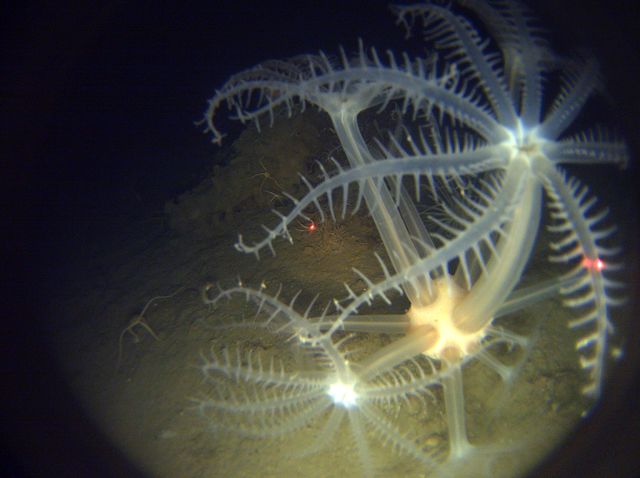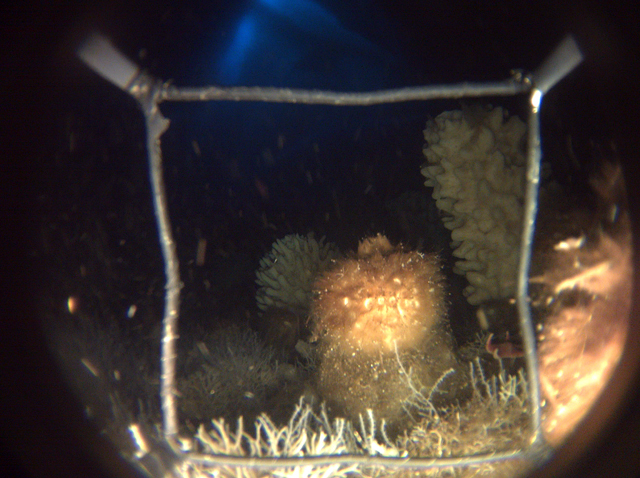SCINI in the SoundRobot offers new views of marine environment around McMurdoPosted May 22, 2009
It seemed unlikely too many marine organisms could make a living under the dark shadow of an ice shelf, with the ice some 200 meters thick in spots. Why? There are not a lot of places for light to penetrate through the ice, which means not a whole lot of photosynthesis, the driving force behind the food chain, is occurring. Also, the front of the McMurdo Ice Shelf, a distinct part of the Ross Ice Shelf Robots in Antarctica
SCINI is just one of a growing number of robots that scientists are using to explore places above and below the ice-covered continent. See the article Robots in Antarctica for more on this subject.
“It’s a long way from any food sources is the bottom line,” said Stacy Kim But Kim and her team of scientists and engineers were still curious as to what the benthic communities might look like, as well as the distribution and abundance of different species. There was only one way to find out: send in SCINI. A remotely operated vehicle (ROV) with a diameter of only 15 centimeters, SCINI (Submersible Capable of under Ice Navigation and Imaging) The idea is that a few people, with just snowmobiles and a sled, or transported via helicopter, can haul SCINI to a new location. Drill a hole, plop it in, and start taking data within an hour or two — the fast-food version of science. In the case of the ice shelf near ice-locked Heald Island, the team found a couple of natural openings — cracks that form at stress points from motion of the McMurdo Ice Shelf pushing around the island — where SCINI could dive through. “Lo and behold we got down to the seafloor and we found high abundances — surprisingly high abundances — of corals and brittle stars and sponges and tunicates,” said Kim, principal investigator on the project and an adjunct professor at Moss Landing Marine Labs “I was quite flabbergasted by the whole thing,” she added. “So now we have this wonderful new question on our hands: What are these animals eating? Where is the food coming from? What energy source supports this community?” Those are enticing questions that will have to wait for another time. The main mission for these three years is to perfect SCINI’s navigation and imaging capabilities. The first season, in 2007-08, SCINI sought out a series of artificial structures, such as cages, used in a series of experiments in the 1960s. The location of the “lost experiments” had been, well, lost.
Until SCINI and a second, commercial VideoRay ROV Last year, the field tests continued, with the goal of perfecting SCINI’s two cameras — one that looks forward and a second that peers downward. “What we wanted to do is be able to pilot it at the same time that we could record imagery data going over the seafloor as a transect,” Kim explained. In addition to the deployments under the McMurdo Ice Shelf, the group went to Cape Evans and Cape Armitage, where it made further surprising discoveries. At Cape Evans, SCINI dove to explore the scour left behind by icebergs — the wreckage of the seafloor as the bergs scraped by. As expected, the icebergs had wiped the seafloor clean where they had passed. However, just on the outskirts of the ice traffic, SCINI sent high-resolution images back to the surface of large, thriving communities of sponges. Another mystery: How could the sponges recover so quickly? Kim said there are at least two possible explanations. Either the iceberg activity is lower than believed or juvenile sponges grow more quickly than when they hit the adult stage. At Cape Armitage, SCINI not only imaged volcano sponges big enough to swallow a diver, but it spied at least two marine species in deep marine troughs that Kim didn’t think existed in McMurdo Sound. One organism (Distalpia cylindrica), which Kim refers to as a “whale snot tunicate,” she had only encountered as a smashed lump recovered in a trawl on the deck of a ship. The second animal, Lyrocteis flavopallidus, is a jelly-like critter adapted to live on the seafloor. It resembles an underwater Venus flytrap, she said. “It sits there with its mouth cocked open, waiting for something to feed it. “It was really amazing to see these animals as part of a living community and develop a little better understanding of how they might act as one component in an ecosystem,” she added. This year, for its final field season, SCINI may head back underneath the ice shelf, though in a more challenging area where a thick layer of frazil ice would test its ability to maneuver and operate through extreme slush. The location, near White Island and home to a unique seal colony, requires special permission to enter. “We want to be sure we can deploy and recover SCINI through that kind of environment. We would like to prove its utility for more general ice shelf conditions,” Kim said. The ROV, designed by engineer Bob Zook, has passed all of its previous tests thus far. Originally built out of off-the-shelf hardware, SCINI has skimmed the seafloor at about 300 meters deep. As the engineers finalize the design, they have swapped out its less sturdy plastic components with metal housings to operate at even greater depths. The last piece scheduled for replacement is the camera dome port. That would free SCINI to go much deeper; many of its newer components are rated to depths of about 2,500 meters. Kim envisions SCINI some day taking on missions below ice shelves or sea ice, or perhaps sent down a deep drill hole to troll through a subglacial lake or even the unexplored realm below an ice shelf. “SCINI as a general resource is capable of doing so many more things than benthic ecology,” she said. NSF-funded research in this story: Stacy Kim, Moss Landing Marine Labs, Award No. 0619622
|



For USAP Participants |
For The Public |
For Researchers and EducatorsContact UsU.S. National Science FoundationOffice of Polar Programs Geosciences Directorate 2415 Eisenhower Avenue, Suite W7100 Alexandria, VA 22314 Sign up for the NSF Office of Polar Programs newsletter and events. Feedback Form |




